A reader and fellow member of Central Oregon Flyfishers sent me this photo from a trail cam in his back yard. He lives overlooking the Middle Deschutes near Eagle Crest. A USFW biologist confirmed that it’s a badger. As the bio said, “pretty cool”!

A reader and fellow member of Central Oregon Flyfishers sent me this photo from a trail cam in his back yard. He lives overlooking the Middle Deschutes near Eagle Crest. A USFW biologist confirmed that it’s a badger. As the bio said, “pretty cool”!

This says it all. An irrigation ditch or habitat for aquatic species? You decide.

On March 30th I wrote a post titled, “It’s spring and fish killing season”, and simultaneously sent it to the Bulletin for their consideration as a guest opinion column. It does not bother me that the paper did not publish my submission. They are a private business, not a public utility, and can chose to publish what they think best serves their economic interests. If they think readers would prefer to see nationally syndicated columnists over local items of interest, it’s their prerogative. Then, two days ago, this article appeared in the paper, which is clearly based on my writing. I have no issue with this either. Writing a longer story based on my submission is fine, the topic deserves more than the 650 words to which a guest column is confined. What does bother me, however, is the continued deference to irrigators and lack of concern for fish and wildlife issues, especially when I so clearly discussed them.
Read More »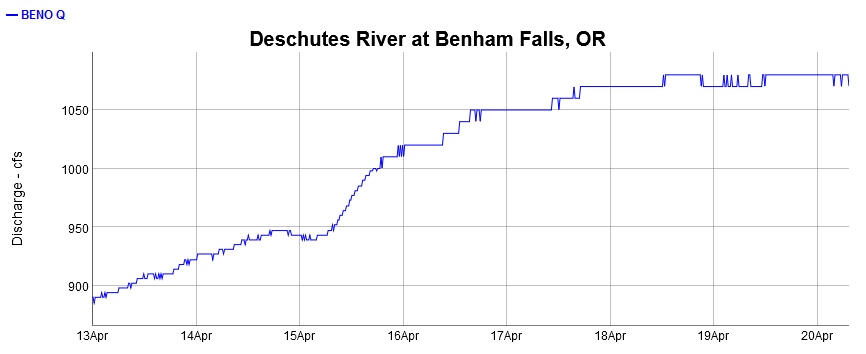
I write a lot about irrigation flows and its impact on local rivers, but today’s graphs once again illustrate the point. Irrigation season is underway with 25% of the water being delivered. This will be ramped up to full delivery by mid-May. Above is the Bureau of Reclamation chart for the Deschutes River at Benham Falls. It shows a relatively measured increase in flows, an increase that has generated sediment in the river but not extreme levels. In contrast, look at the chart for the river below the final irrigation diversions at North Canal Dam.
Read More »
I recently wrote about how the beginning of irrigation season can be lethal to fish and gave an example of Three Sisters Irrigation District abruptly de-watering part of Whychus Creek last month, killing spring chinook smolts being prepared for release into the creek. Yesterday I accompanied a local agency employee to the acclimation tank to take a look.
Read More »Spring brings the beginning of irrigation season in Central Oregon. Irrigation districts usually start water deliveries around April 15 and ramp up to full delivery around May 15. This typically continues until mid-September when deliveries are reduced until mid-October when irrigation season ends. The period 30 day periods at the beginning and end of irrigation season are known as “shoulder” seasons. I think of the spring shoulder season as fish killing season.
Read More »Oregon Public Broadcast recently ran a story, “Solutions to Oregon’s drought could be found in the Deschutes Basin”, that had some good information but also errors and misleading statements that need to be addressed. Like most articles on water in the Deschutes Basin, it provided a false equivalence between the Upper Deschutes and the entire Deschutes River. “And yet, as a megadrought grips the West, the Deschutes Basin has rebounded from dire straits in the early 2000s. Today, conservation measures are leaving 10 times more water in the river than was protected for Mother Nature in 2002.” (Really?*) While it is true that the Upper Deschutes (headwaters to Bend) has seen an increase in flows, the Middle and Lower Deschutes are not seeing any benefit from piping.
Read More »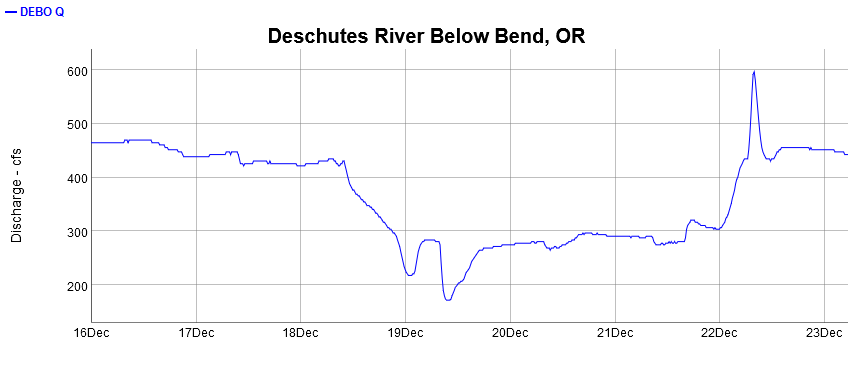
Central Oregon Irrigation District has now finished their latest “stock run” and you can see its impact on the Middle Deschutes below Bend. Over the course of 5 days the river level has fluctuated wildly with a low of 172 cfs and a high of 592 cfs. Such dramatic swings in a short period of time expose the river bed and its plants and aquatic insects to potentially lethally low temperatures. High flows then generate sediment which chokes spawning beds. Of course, this has been going on for years. With all the focus on restoring the Upper Deschutes (the river above Bend), the Middle Deschutes continues to be an irrigation ditch.
Read More »Last month the Oregon Water Resources Commission approved grants collectively worth $12,232,393 to Ochoco, Arnold, North Unit, and Tumalo irrigation districts for canal piping and related projects. With a total cost of $83,355,578, these efforts will place just under 30 cfs (cubic feet per second) of water back instream. The environmentalist in me understands the benefits of these projects. Our local rivers and streams are in terrible shape, impacting fish, wildlife, recreationists, and our local economy. The taxpayer in me is not enthusiastic about paying an average of $2,785,483 per cfs.
Read More »You’ve all heard about the annual fish “salvage” on the Upper Deschutes River above Bend. Periodic dewatering of the river by irrigation districts and the stranding of fish has been going on for decades but it recently has had negative press resulting in limited efforts made to save some fish. When this started I spoke to ODFW who said they wanted nothing to do with it. The salvage only occurs on a very small part of the river where hikers can easily see it, is mostly a feel-good PR event with no measurable biological impact, and the burden should be on the irrigation districts to better manage the river and perform any needed fish rescue operations. I stopped writing about this a long time ago, but here’s a recent no-holds-barred article on the topic from Bend resident George Wuerthner.
I’m sure you have all been hearing about the end of irrigation season in Central Oregon, the reduction in flows coming out of Wickiup Dam as it is refilled, and the fish salvage operation just above Bend. You probably have not heard about the corresponding havoc on the Middle Deschutes, however.
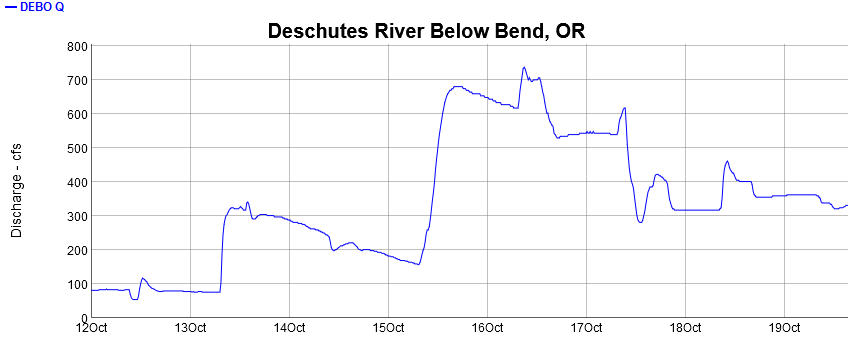
Recently, there have been some articles and letters regarding canal piping in the Bend Bulletin. IMHO, many of them lacked important context, so I submitted yet another column on the topic, which was printed today. Of course, given the 650 word limit my column was cursory at best, but I think it got the point across. For those of you who do not have subscriptions (you should), here’s what I wrote.
Read More »It’s irrigation season and, as usual, the Middle Deschutes is getting killed. Below are graphs showing flows in the Deschutes just below the Central Oregon Irrigation District and North Unit Irrigation District diversions at the North Canal Dam just upstream from the Mt. Washington bridge in Bend. As you can see, over the past two weeks fluctuations in the river have been abrupt and dramatic. This strands fish and other aquatic life and stirs up sediment that chokes spawning beds. (CORRECTION: in the section below on gas bubble disease, I missed a zero. Gas bubble disease is a real problem around 3,000 cfs, not 300 cfs as originally stated and now corrected. Sorry about that. Flows this morning out of Bowman Dam are are 2,020 cfs with inflows at 4,500 cfs.)
Read More »
Central Oregon Irrigation District has announced that their main canals will “turn on” starting April 10. North Unit Irrigation District is scheduled to start April 15. Nonetheless, I drove over a main canal today and it has water in it. So, here are some thoughts about the outlook for this irrigation season and its impact on local fisheries. We have been very lucky with late season snowfall, but it’s not as good as it is often portrayed to be. Our reservoirs, lakes, and rivers will need a lot more than one decent winter snowpack to return to healthy conditions.
Read More »I am a frequent critic of local and statewide politician’s lack of attention to water use and scarcity but a small step in the right direction is currently being considered in the legislature. HB3124, titled the “Bipartisan Drought Relief and Water Security Package”, has elements that would begin to address important issues. It would direct the Oregon Water Resources Department to “study” drought (really, the legislature needs to direct OWRD to do this?) and include strategies for drinking water, agriculture, fish, and water projects. Locally, it would allocate $2 million to the Deschutes River Conservancy. The next public hearing and work session is on April 3rd. Keep reading for background information, some resources, and my criticisms (of course).
Read More »
By now I’m sure you are all fully familiar with the Bureau of Reclamation graph of local reservoirs and rivers used to irrigate the high desert. In non-drought years the reservoirs are full early in the irrigation season, but only Crane Prairie and Haystack are near that level today. Haystack is an intermediate reservoir used by North Unit Irrigation District to temporarily hold water from Wickiup and Crane Prairie is kept full early in the season for Oregon Spotted Frog habitat as required by the Deschutes Basin Habitat Conservation Plan. What is less well known is the dramatic change in river levels caused by irrigation diversions, a change which is lethal to many forms of aquatic life.
Read More »“Water banking”, also known as “water marketing”, is a well understood method of applying economic principles to water allocation. In short, it allows water rights holders to sell or lease their water to others who could derive more economic value from it. After significant effort, the Deschutes River Conservancy is establishing a voluntary pilot program for Central Oregon Irrigation District patrons to temporarily allocate their water to North Unit Irrigation District. The Bend Bulletin had a good story on this topic last week which was later picked up by Oregon Public Broadcasting. Here’s additional discussion including some areas that need work.
Read More »My recent post of an email conversation with a Redmond resident received a lot of interest. Here is the 3rd email exchange I have had with him. The 2nd exchange did not add much to the conversation, but I think some readers might get something out of this one. Once again, another great example of how polarized we are and how much work needs to be done.
Read More »Today the Bend Bulletin published my opinion piece on North Unit Irrigation District’s outline of a proposal to pump water out of Lake Billy Chinook for irrigation. The column in the paper is a variant of a post I made in September. I was going to let this issue go, but NUID published a guest column in the paper and I felt it needed a response. For those of you who do not have a subscription (which you should), here is the column:
Read More »
The Bend Bulletin has recently had a couple of good articles on the end of irrigation season which I wanted to comment on. “Deschutes River users brace for annual ramp down of water” discusses how Central Oregon Irrigation District has turned off their water deliveries as they prepare for additional main canal piping. “Water flows to some farmers cut off from irrigation due to drought” discusses how water is being turned on for the next 2 weeks to both North Unit Irrigation District and Arnold Irrigation District. While these are well written articles, and I appreciate the Bulletin’s continued coverage of local irrigation water issues, I believe some clarification and discussion is warranted.
Read More »North Unit Irrigation District (NUID) is working on plans to pump up to 400 CFS of water from Lake Billy Chinook (LBC) for use by their patrons. The Bend Bulletin recently had a positive story about it as well as an editorial endorsing the idea. This could be an attractive idea but there are simply too many unknowns to have an informed opinion, and there are reasons for concern. The devil is in the details, and we don’t know the details.
My first reaction is that a pumping station at LBC will be another expensive taxpayer funded project for private benefit, may shift water availability and quality issues from one part of the Deschutes River to another, and would not be necessary if the core issues of the water scarcity crisis were addressed. Water waste and misappropriation is our disease. Do we need to spend another $400M of taxpayer dollars for pumping on top of the $1B dollars already needed for canal piping to cure it?
Read More »That’s the title of another good column by Tod Heisler of Central Oregon Land Watch in today’s Bend Bulletin. His themes should be well known to readers of this blog, but it’s worth the quick read. The message needs to be repeated over and over. I wish more people than Tod and me were speaking up.
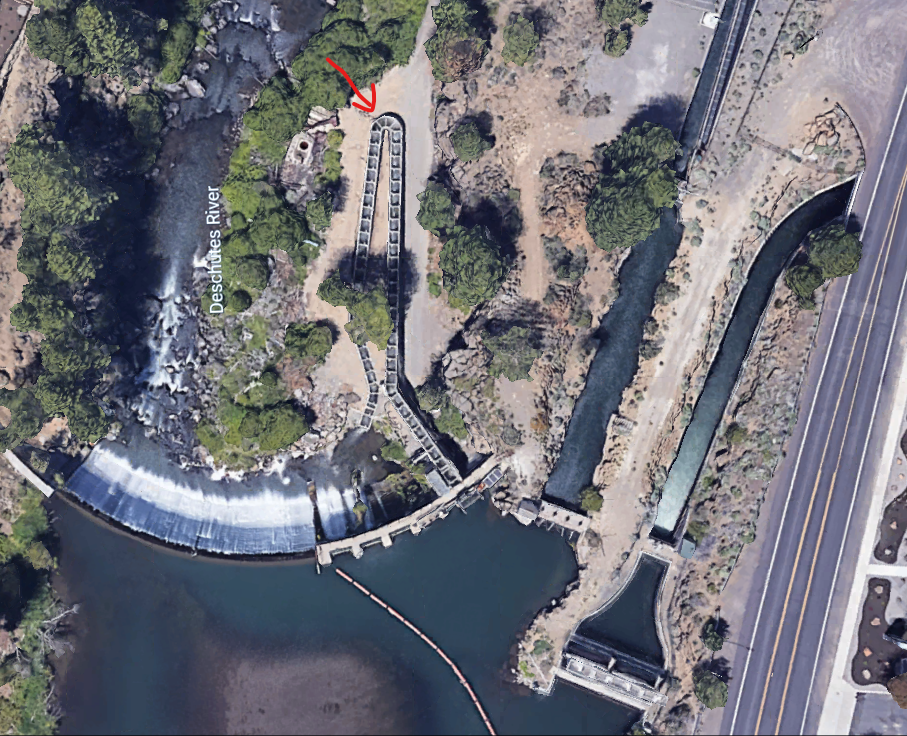
North Canal Dam, located just upstream from the Mt. Washington bridge in Bend, is the northernmost irrigation diversion dam on the Deschutes River. Built in 1912 and 33 feet high, it is the largest and oldest dam in Bend. A fish ladder was required to be installed in 2017, providing upstream fish passage for the first time in over 100 years. The dam is on the left in the image above, two major irrigation canals are on the right, and the fish ladder is in the middle, indicated by the red arrow.
Read More »
Tod Heisler at Central Oregon Land Watch wrote a really good post for their blog, “Drought and the Deschutes: Looking at the same river twice“. It succinctly covers a topic I write about a lot: the dramatic difference in flows above and below Bend during irrigation season. I highly recommend it. Here’s some more color to this discussion: many local groups promote the Middle Deschutes as a success story. In fact, just yesterday I was in a meeting where a local prominent NGO and a government employee did just that. Once again, I lost my cool. Historically, the Middle Deschutes as it flows through Bend should be somewhere over 1,200 CFS right now. A few days ago it was at 62 CFS. That’s 5%* of the historical flow. True, 62 CFS is better than nothing, but we have a very long way to go before this stretch of the river is healthy again.
(*Yes, I made a stupid math error in the first version of this post, now corrected. I need a proof reader / editor sometimes.)
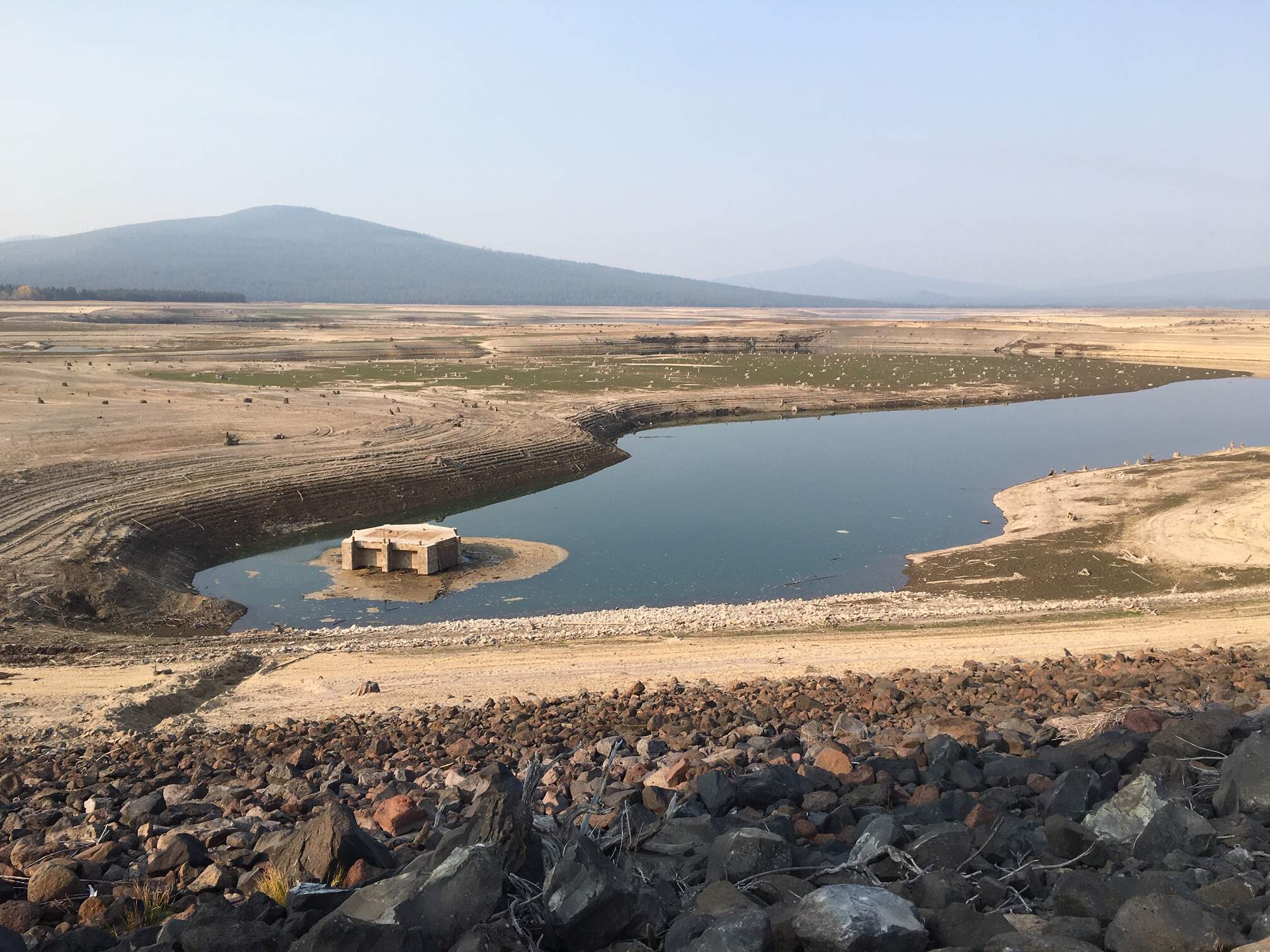
For a couple of years I have been attending/viewing presentations put on by the Central Oregon Geoscience Society (COGS). I am not a geologist, but the talks have been educational and are occasionally about topics of particular interest to me like local hydrology and hydrogeomorphology. On April 27, Kyle Gorman, long time Central Oregon Region Manager for the Oregon Water Resources Department, gave a presentation titled, Water in the Deschutes Basin: 2020 Hindsight – What Happened? (Click on the title to see a replay.) Kyle discussed local hydrology and water use by irrigators. His presentation even had a couple of informative slides I had not seen before. (Check out the “CDA” graph at about minute 40.) It was a good overview of water issues many of us have been tracking for years, and I recommend viewing the replay of his talk, and perhaps joining COGS if you are interested in presentations like this.
I was surprised, however, by Kyle’s dismissal of global warming as a causal factor in current water shortages. Keep reading for comments on that.
Read More »
Sadly, as I have written about many times, it is irrigation season and once again the Middle Deschutes below Bend is being killed. According to the US Bureau of Reclamation gauge, the Middle is currently flowing at 64 CFS. Prior to the installation of upstream dams and irrigation withdrawals, this section of river would be flowing around 1,200 CFS. Not only are the flows lethally low, they are erratic (see the chart below). The photo above is from a Central Oregon Irrigation District email last month that provided the irrigation startup schedule to their patrons. I was struck by their use of this image, as I will explain below.
Read More »On April 3rd, the Bend Bulletin ran a very misleading article, Deschutes River level to rise as irrigation season begins, so I am glad they printed Tod Heisler’s response. The Bulletin’s article omitted much and contained inaccuracies, like showing a picture of the river at Sawyer park and claiming that the river will rise there when it will actually fall. Tod did a good job of providing a more complete and accurate description of the irrigator’s impact on the river.

It appears that yesterday was the first day of this year’s irrigation season in Central Oregon. Once again, local irrigators showed their disregard for the Deschutes River, dropping the river below Bend from 470 CFS to 107 CFS in 10 hours. Such a rapid, deep decline in flows strands and kills fish along with the aquatic insects the fish feed on. Of course, this has been going on for over 100 years and is why the Middle Deschutes is in such terrible shape. It also shows, once again, that without the threat of a lawsuit, the irrigators will not change their behavior. (Irrigation season is somewhat variable but partial deliveries start in early April and ramp up through mid May with full deliveries.)
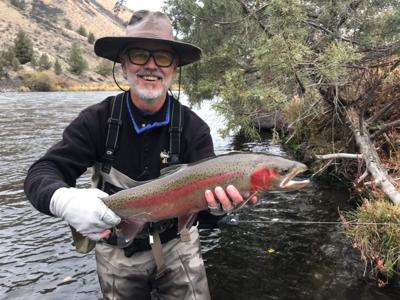
My latest column appeared in the Bend Bulletin today. Once again, I appreciate their increased coverage of local conservation issues and occasionally letting me submit something. If you don’t have a subscription or have used you your free views for the month, here’s the text.
The Bulletin recently ran a column titled “Central Oregon Crossroads: Are we moving fast enough to protect our waterways?”. I always appreciate water articles and commentary, but the column did not address numerous local issues. Here’s a brief, partial overview.
Read More »
As I wrote last December, an application for a private airstrip between Bend and Redmond right next to the Deschutes River in an Exclusive Farm Use Zone has been submitted to Deschutes County. Today, notice was given that the application was denied but is subject to appeal. I believe this is the correct decision. Private airstrips are fine, but not if they are next to a river where people recreate, eagles nest, and mule deer and elk use for winter habitat.

A new 2,000 foot long airstrip adjacent to the Deschutes River between Bend and Redmond is being proposed. The application is for a private airstrip, but commercial use is allowed. Your favorite mapping program will show that 20925 Harper Road is nearly adjacent to the Maston trail system and the flight path will go over other houses. I’m all for property rights, but this is something else. Parts of Maston are seasonally closed to protect nesting eagles. Nearby Cline Buttes Recreation Area is winter range for deer and elk. Hikers, equestrians, and cyclists use these areas year round. It’s not the best fishing, but I’ve hiked down to the river there. Why do the desires of a single property owner supersede the needs of wildlife and the public’s tranquil use of this area?
Read More »
This morning the Bulletin covered the sediment flows into the Deschutes from Wickiup Reservoir. It’s worth a quick read.

This morning I received an email titled “The big muddy” with the photo above and this text: “This is a photo of the Deschutes about 5 miles south of Sunriver at about 4:00 pm, September 15, 2020. I’m guessing that the emptying of Wickiup Reservoir has many years worth of sediments, accumulating at the bottom of the reservoir, now washing down stream.” Seems like a reasonable guess to me.

As expected, Wickiup Reservoir has been emptied, all that currently remains is the Deschutes River in it’s historical river bed. The Bend Bulletin had a good story about it in today’s paper. Clearly, this is terrible news for farmers who rely on this water. That being said, look at the charts below for some perspective.
Read More »As reported by The Bulletin on August 28th, Lone Pine Irrigation District is the latest local district to run out of water to deliver to their patrons. This is terrible news, no one wants to see farmers losing their livelihoods. Water is a complicated topic in Central Oregon with many factors contributing to the shortage. Unfortunately, rather than addressing the real issues, Terry Smith, chairman of the board for LPID, places the blame on the Endangered Species Act.
Read More »
Counter Punch ran this article today from Bend resident George Wuerthner reacting to the current mismanagement of the Middle Deschutes and asking if we should completely rethink how water should be used.
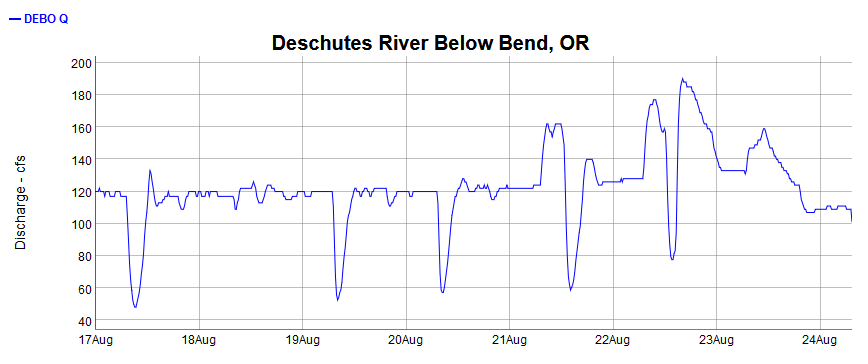
This is no way to manage a river for fish, wildlife, or recreation. Simply incredible.
Today, the Bulletin covered the current erratic flows in the Middle Deschutes caused by the last irrigation diversion in Bend. I too had been told that the issue had something to do with automatic gate malfunctions from debris clogging the gates or perhaps upstream flow fluctuations from the whitewater park or the PacificPower dam that creates Mirror Pond. I wonder.
Read More »
This week has seen multiple, abrupt 50%+ drops in the Middle Deschutes below the last irrigation diversion near the Mt. Washington bridge. Clearly, this is ecologically devastating to aquatic life. It is also arguably illegal. Enough senior water rights have been transferred to the river to keep flows around 120 CFS at this time of year. So far this week the river has been dropped to 48, 53, and 57 CFS. Oregon Water Resources Department says there is an issue with North Unit Irrigation District’s automated gates, but the damage is still being done.

Here’s how our local reservoirs and rivers look as of the end of the day yesterday (click here for a direct link). Crane Prairie still has a lot of water as it is held fairly constant until late summer to maintain endangered species habitat. Haystack is nearly full as it is intermediate storage for North Unit Irrigation District. NUID’s main storage is Wickiup which will most likely be empty before the end of irrigation season. Prineville Reservoir is managed for both irrigation and fish. As of August 5th, it has 41,820 acre feet of irrigation water and 23,380 acre feet of “fish water”.
Read More »I asked Jeremy Griffin, our local water master, what happened yesterday with the flows on the Middle Deschutes. He said the automatic gate for the NUID canal at the North Canal Dam “went wild” for a while. While my concern for the ecological damage that was caused by the huge, rapid drop is justified, I assumed that the drop was purposeful rather than accidental. That assumption was based on watching the irrigators create frequent, sudden drops for many years (although not quite as large). Nevertheless, I should have investigated it before making my post. For that, I apologize. I hope that they can get their equipment fixed, and soon.

Right now, the Middle Deschutes is at 48 CFS. In the 16 or so years that I have tracked flows, this is the lowest I have seen. So much for all the posturing on the part of the irrigation districts about caring for the environment. When push comes to shove, they get all the water. They didn’t even slowly ramp flows down to give fish a chance to move out of side channels. The river dropped from 117 CFS to 48 CFS in only 2 hours. We have known for years that drought and water shortages will come but little has been done to prepare for it.
UPDATE: Since hitting a low of 48 CFS around 9 AM this morning, the flows were returned to around 120 CFS at 12:30 PM. So, it looks like I jumped the gun somewhat in my post. Nevertheless, a 50%+ drop in less than 2 hours was more than concerning and will create environmental havoc. Like I have said so many times before, just like us, fish and other aquatic life need to breathe all the time, not just most of the time. It is also the case that very little has been done to prepare for the hot, dry future that we are going to live in and the irrigators continue to control almost all of the water in the Deschutes from the headwaters almost to Lake Billy Chinook.

One of the primary disagreements between the irrigators and conservation groups is the relative importance between canal piping and improving efficiency in the use of water. For a variety of reasons, the irrigators are focused on piping their main canals. The Basin Study Work Group, however, showed that water could be more cheaply and quickly saved via other techniques including the use of modern irrigation methods and simple water conservation. I saw a great example of this while on a hike along the Deschutes yesterday.
Read More »Tod Heisler has a great column in today’s Bend Bulletin titled, “The fallacy of in-conduit hydropower”. It’s worth reading, but the gist is that hydro power plants installed into piped canals encourages the continued overuse of water, even when it is not needed, in order to keep the power plant running. Of course, this maintains the irrigator’s legacy of keeping water levels in local rivers and streams below what is needed for a healthy ecosystem.

“The Deschutes River’s beauty hides problems”, was an editorial in yesterday’s Bend Bulletin. I continue to be pleased with the paper’s new commitment to environmental coverage. The problems facing the Deschutes River are numerous, complex, and often rooted in decisions made a century ago. Few people, or even some organizations claiming to be advocates for the river, really have a grasp of the broad range of interwoven issues: water law and rights, hydrology, global heating, tax policy, groundwater recharge, mitigation, economics, biology, etc. It really is a fascinating area that I have been studying for over a decade. In that context, I think the Bulletin’s editorial did a fine job of skimming the surface of a few current high-profile issues. In the future, I hope they can provide broader and more nuanced coverage.
Read More »Swalley Irrigation District and the Deschutes River Conservancy recently announced the completion of piping a 3 mile stretch of canal which will restore about 1.8 cubic feet a second (CFS) of flow to the Middle Deschutes during peak irrigation season. 1.8 CFS is about 13.5 gallons. Picture 5-gallon buckets, two full and one 2/3rds-full. Put them on their side and that’s the size of the stream they would create. Restoring water to the river is always good news, but this announcement is a great example of the complexity of the issue.Read More »
Today the Bulletin ran a guest column, “$1 billion is too much to give irrigation districts in these times“, by Tod Heisler of Central Oregon Land Watch. Clearly, I agree with Tod that the current plan is the wrong one. My first letter to The Bulletin criticizing water and canal management by local irrigation districts was over 10 years ago. Hopefully we can get past identifying the problem and finding real solutions to our local water issues before lack of adequate funding, a growing population, and a heating planet create a full-blown crisis. Of course, it already is a crisis for local fish and wildlife.
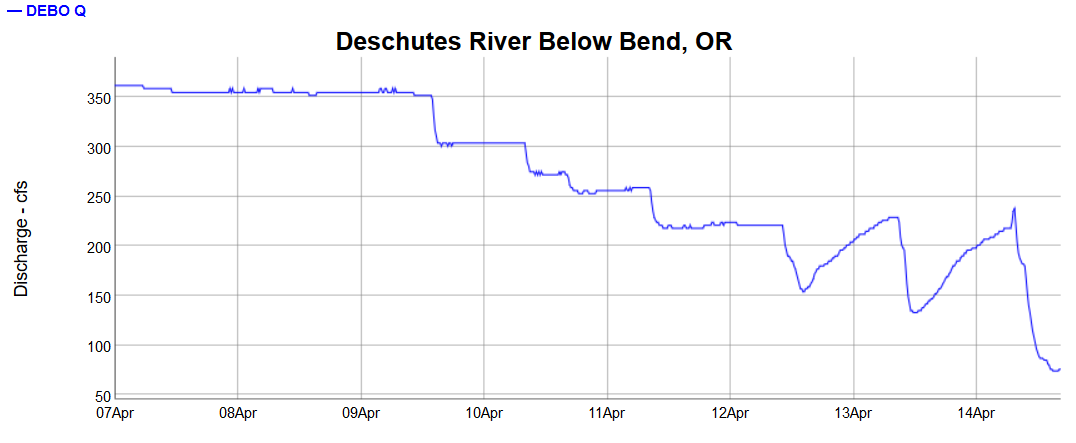
Today the Middle Deschutes below North Canal Dam was lowered to 74 CFS. The average for this time of year is 470 CFS. Historically it would be at least 1,000 CFS. I took the first photo this afternoon just below the dam, the river has been turned into frog water and much of the bank and what was habitat has been exposed. The second photo is at Sawyer Park. Look at this entry to see the see a similar view 10 days ago when it was at 310 CFS.Read More »
On March 30th the Bulletin had a front page article about some of the ecological problems facing the Upper Deschutes. In response, I quickly submitted a guest column pointing out that the Middle Deschutes is suffering from the same issues. They have not published my column, so here it is for your consideration.Read More »

As I recently posted, last Monday through early Wednesday the irrigators raised the level of the Middle Deschutes almost 50% from 410 CFS to 600 CFS before dropping it to 250 CFS in about 6.5 hours during the day Wednesday. Today I had to go into Bend so I stopped by Sawyer Park to take a look.

Unfortunately, I am given frequent reason to post about the environmental destruction to the Middle Deschutes from abrupt, drastic irrigation withdrawals. Today is a particularly egregious example. In 2 days flows in the river were increased from 410 to 600 CFS and then dropped to 250 CFS in just a few hours! Where’s the news coverage showing all the stranded fish in the side channels in the middle? Why don’t the irrigators slowly ramp down flows in the Middle Deschutes like they do in the Upper Deschutes? Business as usual for the irrigators is the business of environmental destruction.

Today I saw that one of the COID main canals near my house was full of water so I checked the graph. As you can see below, there have been some pretty dramatic fluctuations in the Deschutes below Bend over the past week. There was an abrupt diversion into the canals on February 10 and it looks like another is starting today. (Note that it can take a few days for the water to make it down the canals.) As I have written before, these sudden fluctuations wreak havoc on the aquatic environment and cause increased sedimentation which fills spawning beds.Read More »
On January 31 the Deschutes River Conservancy announced that they had secured funding from Intel Corporation to help with their middle Deschutes summer water leasing program. Without the DRC’s various efforts, including the leasing program, the middle Deschutes below Bend would be virtually dry in the summer. Additional funding for the leasing program is welcome news but requires some context.
Flows in the Deschutes above Bend are controlled by irrigation districts who withhold water to fill reservoirs in the winter and release water in the summer which is then diverted into a series of irrigation canals. The last major diversion is located at the North Canal Dam in Bend just upriver from the Riverhouse. During irrigation season the Deschutes below this dam is reduced to a relative trickle, dramatically damaging the ecosystem for fish and wildlife. Read More »
Today the US Fish & Wildlife Service held a public update meeting on the Habitat Conservation Plan status. I’ve written extensively on the HCP in this blog but, briefly, it is an application by Central Oregon irrigation districts and the City of Prineville to continue to withdraw water from local rivers while incidentally “taking” (killing) endangered species like bull trout, steelhead, and the Oregon Spotted Frog. The meeting had a wealth of information but the shocker for me was an admission by the irrigation districts that they have been badly mismanaging flows in the middle Deschutes.Read More »
Here’s the latest graph of flows in the middle Deschutes below North Dam in Bend near the Riverhouse. On November 26 the river got down to 63.8 cfs. On a relative basis, that’s worse than 20 cfs in the upper Deschutes below Wickiup. Years of discussion and “cooperation” at the Basin Study Work Group between the irrigators, government agencies, and various other groups has made no improvement in how the river is managed. For the second time this year the irrigators have killed the middle Deschutes (visit the prior post for a more detailed discussion of this topic).

Irrigation season has started and once again the middle Deschutes is suffering. As you can see on the Bureau of Reclamation website, the Deschutes River below North Dam (just upstream from the Mt. Washington bridge) is now reduced to 62 cfs. As I argued in this post, recent levels are least as damaging as what happens in the upper Deschutes below Wickiup Reservoir in the winter. The flows should come back up a little later in the spring as the irrigators allow some additional flows but by that time the damage will have been done. The exposed river bottom will kill fish eggs, the aquatic insects that fish eat, and the plants that the insects need. In spite of all the time, effort, and money put into restoration the Deschutes continues to be no more than an irrigation ditch for the benefit of a few irrigators to the detriment of the rest of us.

UPDATE: a reader pointed out to me that my graph only covers the past 2 weeks. If you go to the BoR site (link above) and run the graph for a longer period you will see that the middle Deschutes was running around 800 cfs for most of the winter. 800 cfs to 62 cfs is a better illustration of just how environmentally damaging the beginning of irrigation season is.
While the upper Deschutes has been the focus of late, the middle Deschutes also needs additional flows. Unfortunately, there are no real plans for this. The middle Deschutes is generally defined as the segment from Benham Falls to Lake Billy Chinook and flows in this section are complex. Read More »